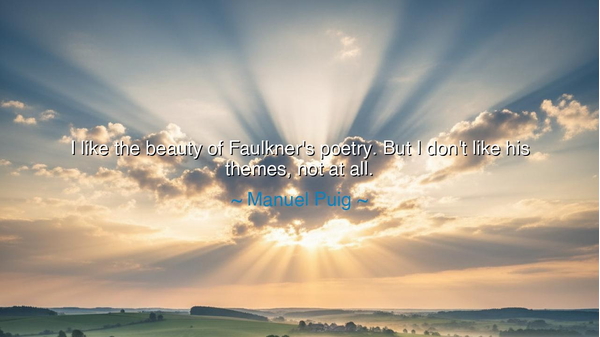
I like the beauty of Faulkner's poetry. But I don't like his






"I like the beauty of Faulkner's poetry. But I don't like his themes, not at all." So spoke Manuel Puig, the Argentinian novelist whose voice was both daring and unconventional. In these words lies a powerful teaching about the dual nature of art: its form and its content. Puig confesses admiration for the beauty of William Faulkner’s language, the richness of his sentences, the rhythm and intensity of his craft. Yet he recoils from Faulkner’s themes, which often dwell in violence, decay, despair, and the haunted legacies of the American South. Thus, Puig reminds us that art can be divided between the vessel and what it carries, and that one may praise the craftsmanship while rejecting the message.
The ancients themselves knew this distinction. The Greeks revered Homer’s Iliad for its grandeur of verse and its heroic scope, yet philosophers such as Plato condemned its themes of rage, bloodshed, and unrestrained passion. They admired the poetry, but feared the themes. For beauty of form has the power to captivate the senses, while the subject matter shapes the soul. And when the subject matter is dark, it risks spreading its shadow through the very beauty that conveys it.
History gives us many echoes of this tension. Consider Richard Wagner, whose music is undeniably majestic, swelling with sublime force. Yet his themes—tinged with nationalism and prejudice—have been condemned for the destructive ideologies they later inspired. Generations after him, listeners still wrestle with the paradox: to delight in the soaring beauty of the music, while rejecting the darkness of the themes. So too did Puig wrestle with Faulkner, admiring his artistry while refusing to bow before the worldview it carried.
Puig’s words also remind us of the freedom of the reader, the hearer, the beholder. We are not bound to accept all of what art offers. One may drink from the stream of beauty without swallowing the bitterness of its themes. This freedom is itself a form of discernment, a way of saying: "I honor the craft, but I guard my spirit from what I do not wish to become." It is a call to be awake when we encounter art, to take what uplifts and to resist what corrupts.
The lesson is stern yet liberating: beauty alone does not sanctify a work. We must look deeper, weighing both form and meaning. The artist may dazzle with language, melody, or color, but if the themes glorify cruelty, despair, or emptiness, we must be cautious in our admiration. To delight in art’s power is good; to surrender uncritically to its message is dangerous. Puig’s refusal is an act of resistance, a way of honoring beauty while preserving integrity.
Practically, this means we must approach all works of art with both openness and discernment. Let us admire the skill of the poet, the painter, the musician—but let us also ask: what vision of life does this art proclaim? Does it lift humanity or degrade it? Does it speak truth or glorify falsehood? If it does both—if it is beautiful in form but troubling in content—then we must learn to separate the two, as Puig did. In this way, we honor the craft without losing our own compass.
So remember, children of tomorrow: "I like the beauty of Faulkner’s poetry. But I don’t like his themes, not at all." To admire art is not to bow before it blindly. To celebrate beauty is not to embrace every message it carries. Walk as those who can see with two eyes: one that beholds the splendor of form, and one that discerns the weight of meaning. For in this balance lies wisdom, and in this balance lies freedom.






TLNguyen Thi Lan
I can see where Puig is coming from, especially when an author’s themes are heavy or controversial. Faulkner’s work is known for being challenging, and while it might be beautifully written, the darker or more complex themes can make it hard to engage with. How do we as readers decide whether to appreciate a work for its artistic qualities or reject it because its themes conflict with our own values?
AVAnh Vu
I think Puig's opinion reveals something about the complexity of literary appreciation. The form of Faulkner’s writing may be beautiful, but if the themes are jarring or hard to digest, does that impact our overall perception of his work? Can we truly separate our emotional response to a work from its technical merit? Or do the themes and form always need to be in harmony for the work to be considered great?
QTNguyen Quang Trung
The tension between appreciating the beauty of Faulkner's poetry and disliking his themes is fascinating. It makes me reflect on how our enjoyment of art often hinges on both form and content. What happens when one element (like beauty) resonates, but the other (like theme) doesn’t? Does this mean we can’t fully appreciate a piece of art if it challenges our beliefs or emotions too much?
LLLam lan
I understand Puig’s sentiment about Faulkner. It’s hard to enjoy certain works if you’re not comfortable with the themes, even if the writing is exquisite. Does beauty in language still have value if the themes it conveys feel inaccessible or disturbing? I wonder if Faulkner's themes, while not universally appealing, serve a larger purpose in forcing readers to confront uncomfortable realities.
TDtuong duy
Puig’s statement suggests a deep divide between the aesthetic and thematic elements of Faulkner’s work. Does this mean that even brilliant writing can be tainted by uncomfortable or unsettling themes? How often do we come across works that are technically beautiful, but whose themes we struggle with or actively dislike? Does this make us appreciate the beauty of the work less, or does it increase our awareness of the power of theme?